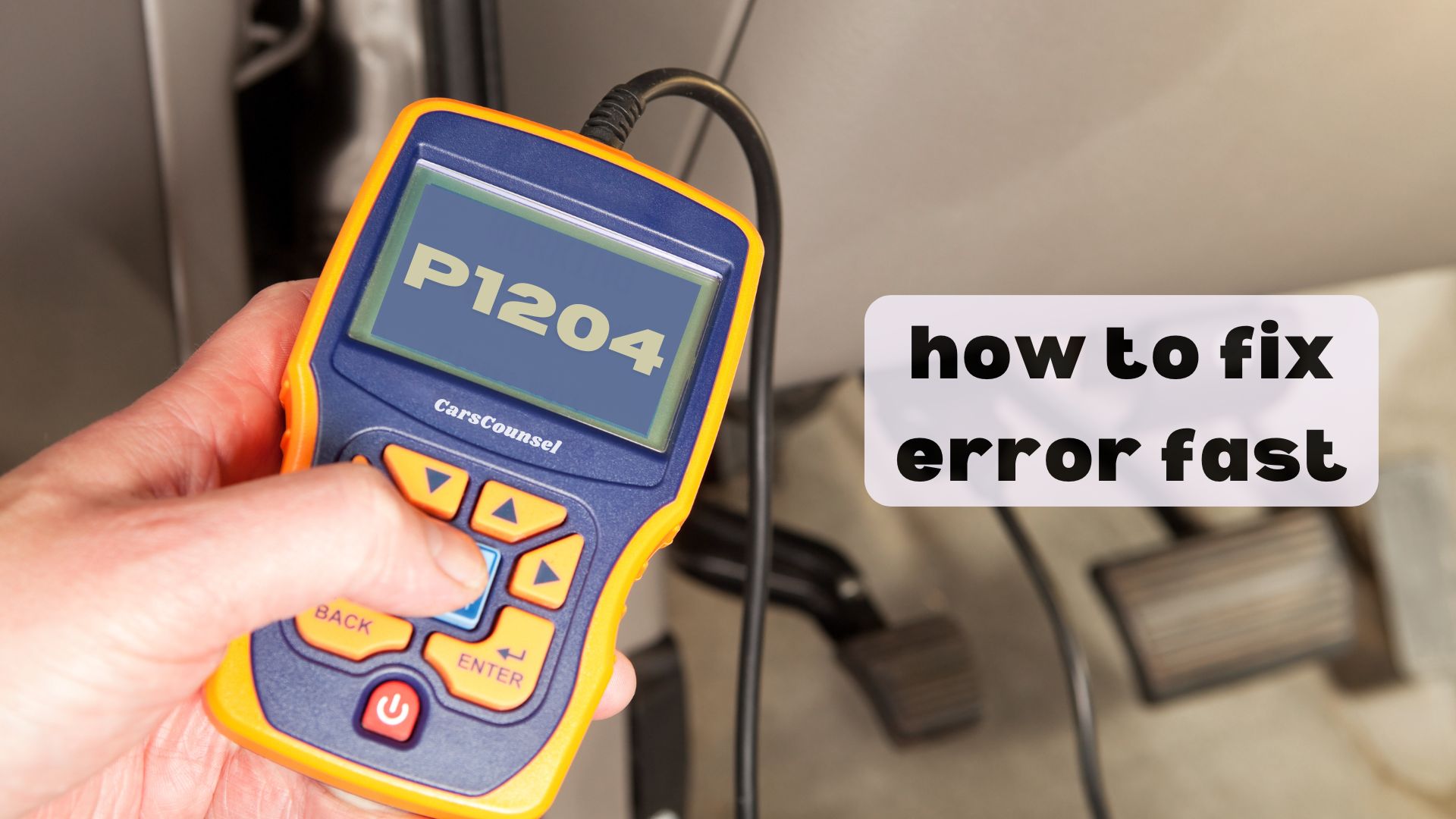When your car’s onboard computer throws a P1204 code, it’s telling you that the fuel system has failed, causing a misfire in the No. 4 cylinder. This can lead to rough idling, decreased power, and poor fuel efficiency. You’ll want to investigate further to identify the root cause, which could be anything from clogged fuel injectors to a malfunctioning fuel pump. As you dig deeper, you’ll uncover a complex web of potential issues – but getting to the bottom of it will be key to restoring your engine’s performance.

Quick Navigation
Key Takeaways
- The P1204 code indicates a fuel system failure causing a misfire in the No. 4 cylinder of the engine, impacting engine performance.
- Common causes include clogged or dirty fuel injectors, malfunctioning fuel pumps, faulty fuel pressure regulators, and restricted fuel filters.
- Symptoms of P1204 include rough idling, decreased power, poor fuel economy, and engine misfires accompanied by the check engine light.
- Diagnosis involves using a scan tool to analyze the code and performing fuel system checks to identify issues with fuel pressure, volume, and component operation.
- Repair may involve replacing faulty parts, cleaning or replacing the fuel filter, and adjusting the fuel pressure regulator to optimize fuel efficiency and power.
Code P1204 Description and Importance
When your vehicle’s onboard computer generates a P1204 code, it’s indicating a fuel system failure that’s causing a misfire in the No. 4 cylinder of your engine.
This issue affects your fuel system overview, which is responsible for delivering fuel to your engine’s cylinders.
As a result, you’ll experience engine performance effects like rough idling, decreased power, and poor fuel efficiency.
If left unresolved, this problem can lead to further engine damage.
It’s vital to address this trouble code promptly to guarantee your vehicle operates efficiently and prevent further damage.
Common Causes of P1204
The P1204 code is often triggered by a handful of common issues within the fuel system.
Common fuel system issues often trigger the P1204 code, requiring swift investigation and diagnosis.
You’ll want to investigate potential problems like a clogged or dirty fuel injector in the No. 4 cylinder, a malfunctioning fuel pump, or a faulty fuel pressure regulator.
Additionally, a restricted fuel filter or wiring/electrical issues related to fuel system components could be the culprit.
Performing fuel leak detection and checking cylinder balance can help you identify the root cause.
Symptoms of P1204
You’ll likely notice a range of performance issues when your vehicle’s engine is experiencing a fuel system failure, as indicated by the P1204 code.
This code typically manifests in abnormal engine sounds and decreased vehicle performance.
Here are four common symptoms to watch out for:
- Rough Idling: Your engine will likely idle rough or shake while running.
- Decreased Power: You’ll experience decreased acceleration and power when driving.
- Poor Fuel Economy: Your vehicle’s fuel efficiency will suffer, leading to increased fuel costs.
- Engine Misfires: You may notice engine misfires or stumbling during acceleration, accompanied by the illumination of the check engine light on your dashboard.
Fuel Injector Issues and Solutions
A clogged or dirty fuel injector in the No. 4 cylinder is a common cause of the P1204 code, leading to the fuel system failure and misfire.
You’ll need to inspect the fuel injector and clean or replace it as necessary. Fuel injector cleaning can be done using a fuel injector cleaning kit, but if the injector is severely clogged, replacement might be the better option.
When replacing the fuel injector, make sure to get an OEM-approved replacement to guarantee proper fitment and function. By addressing the fuel injector issue, you’ll be one step closer to resolving the P1204 code and getting your engine running smoothly again.
Fuel Pump Malfunction and Replacement
Faulty fuel pump operation is a prime suspect in the P1204 code investigation, as it can severely impede fuel delivery to the No. 4 cylinder, leading to a misfire.
Faulty fuel pump operation is a prime suspect in P1204 code investigations, impeding fuel delivery and causing misfires.
To diagnose a faulty fuel pump, you’ll need to perform a fuel pump diagnosis, which may involve pressure testing and electrical circuit checks.
If replacement is necessary, follow these pump replacement tips:
- Ensure the correct replacement pump is selected for your vehicle’s make and model.
- Disconnect the battery to prevent any accidental engine starts during replacement.
- Relieve fuel system pressure before disconnecting fuel lines.
- Consult a repair manual or a professional if you’re not comfortable with the replacement process.
Fuel Pressure Regulator Problems and Adjustments
Since the fuel pump has been ruled out as the cause of the P1204 code, your attention turns to the fuel pressure regulator, another key component that can significantly impact fuel delivery to the No. 4 cylinder.
Check the fuel pressure regulator for signs of malfunction, such as leaks, corrosion, or worn-out components. Adjustments may be necessary to guarantee the correct fuel pressure, which is critical for proper engine operation.
Use a fuel pressure gauge to test the system, and adjust the regulator as needed to achieve the recommended fuel pressure, thereby certifying that the engine operates within specified parameters.
Fuel Filter Restrictions and Cleaning
Most fuel filters are designed to capture contaminants as small as 10-15 microns, but over time, they can become clogged with debris, restricting fuel flow to the No. 4 cylinder and contributing to the P1204 code.
You should perform a fuel filter inspection regularly to guarantee peak fuel system performance.
- Check your owner’s manual for the recommended fuel filter replacement interval.
- Inspect the fuel filter for signs of contamination or damage.
- Clean or replace the fuel filter as needed to maintain proper fuel flow.
- Consider upgrading to a high-performance fuel filter for improved filter maintenance to certify superior fuel system operation.
Wiring and Electrical Issues in the Fuel System
When diagnosing the P1204 code, it’s essential to inspect the wiring and electrical components of the fuel system, as issues in this area can cause the fuel system failure leading to the No. 4 cylinder misfire.
You’ll want to check for faulty connections, corrosion, or damage to wiring and electrical components. Electrical shorts can also cause the fuel system to malfunction, leading to the misfire.
Make sure to inspect the fuel injector wiring, fuel pump wiring, and fuel pressure regulator wiring for any signs of damage or corrosion. Addressing these issues can help resolve the P1204 code and get your engine running smoothly again.
How to Diagnose P1204
What’s causing your engine to misfire?
To diagnose the P1204 code, you’ll need to perform some key checks.
Diagnosing the P1204 code requires a methodical approach, starting with key system checks.
First, use a scan tool to analyze the code and identify any trouble areas.
Next, perform fuel system checks to identify issues such as:
- Fuel pressure and volume
- Fuel injector operation
- Fuel filter condition
- Fuel pump performance
Repair Difficulty and Recommendations
Now that you’ve identified the root cause of the P1204 code, it’s time to tackle the repair.
With a repair difficulty level of 3 (Hard), you’ll need to be prepared for some complexity.
Start by performing thorough fuel system checks to verify all components are functioning correctly.
Next, consider engine performance tweaks to optimize fuel efficiency and power.
Be prepared to replace faulty parts, such as clogged fuel injectors or malfunctioning fuel pumps.
If you’re not comfortable with the repair, consider consulting a professional mechanic to guarantee the job is done correctly and safely.
More OBD-II Codes
| P1202 | P1203 | P1198 | P1146 |
| P1145 | P1144 | P1143 | P1142 |
| P1140 | P1139 | P1141 | P1138 |
| P1137 | P1222 | P1221 | P1214 |
| P1213 | P1212 | P1173 | P1325 |
| P1245 | P1244 | P1243 | P1225 |
Frequently Asked Questions
Can I Drive My Vehicle With the P1204 Code Illuminated?
You shouldn’t drive your vehicle with the check engine light on, as it poses driving risks and worsens fuel efficiency, leading to decreased performance and potential engine damage; instead, address the underlying fuel system issue promptly to guarantee a safe and efficient ride, and also to certify a smooth journey.
Will the P1204 Code Cause Damage to Other Engine Components?
If you don’t address the faulty fuel injector, it may lead to uneven cylinder pressure, causing a domino effect of damage to other engine components, such as the engine block, piston rings, and valves, resulting in costly repairs down the road.
How Long Does It Take to Diagnose and Repair the P1204 Code?
You’ll typically spend around 1-2 hours diagnosing the issue, depending on the repair complexity, and another 2-4 hours for repairs, making the overall diagnostic timeframe around 3-6 hours, considering the intricate fuel system components involved.
Can I Reset the P1204 Code Without Fixing the Underlying Issue?
You’re likely to waste 10% of your fuel due to misfires, but can you reset the code without fixing the issue? No, don’t try code manipulation; instead, address the root cause, which might involve fuel injector cleaning, to avoid further damage and guarantee a proper repair.
Will the P1204 Code Trigger Other Diagnostic Trouble Codes?
You’ll likely see additional codes triggered if the underlying issue isn’t addressed, such as a fuel injector leak or cylinder misfire pattern, which can set off codes like P0304 or P0171, indicating a more widespread fuel system problem.
Conclusion
As you put the puzzle pieces together, the P1204 code‘s mystery unravels, revealing a fuel system failure that’s been holding your engine back. Like a conductor leading an orchestra, you’ve identified the discordant notes – clogged injectors, malfunctioning pumps, and restricted filters – and replaced them with harmony-restoring solutions. Now, your engine’s melody is smooth, powerful, and efficient once more, like a well-oiled machine.

